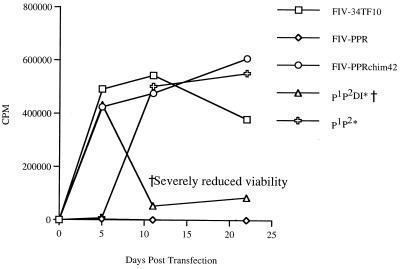FIG. 3.
Graphic representation of transfection studies with the mutant constructs. G355-5 cells were transfected with FIV-PPR, FIV-PPRchim42, FIV-34TF10, and 11 mutant FIVs possessing combinations of Env mutations that distinguish FIV-PPR and FIV-PPRchim42. Release of pelletable RT activity into the culture supernatant was then monitored over a 3-week period. The results indicated that only viral constructs containing a specific combination of three mutations were able to replicate on G355-5 cells and mimic the phenotype of FIV-PPRglial. Specifically, these were a glutamine-to-proline change in C2, a threonine-to-proline change in V4, and the premature truncation of the cytoplasmic tail by the incorporation of a stop codon. All of the mutants were replication competent to wild-type levels on MCH5-4 T cells (data not shown); therefore, the inability to grow on the adherent cells was not due to replication-deficient constructs. All single and double mutants (listed in Fig. 2) were negative of productive growth in G355-5 or CrFK cells but were fully infectious on MCH5-4 T cells (data not shown).

